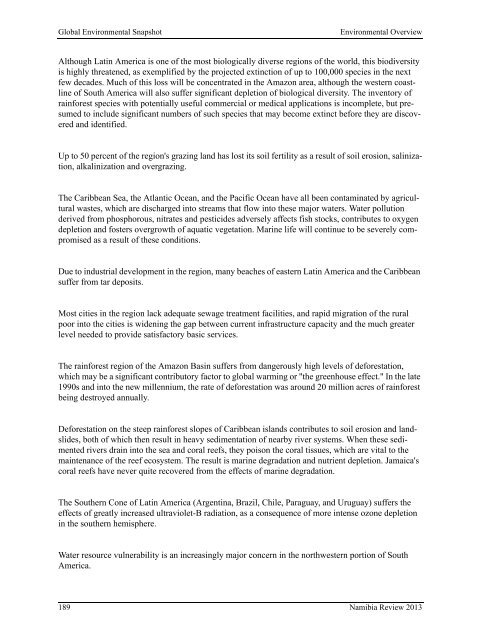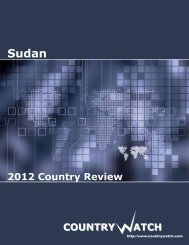Namibia - CountryWatch
Namibia - CountryWatch
Namibia - CountryWatch
You also want an ePaper? Increase the reach of your titles
YUMPU automatically turns print PDFs into web optimized ePapers that Google loves.
Global Environmental Snapshot Environmental Overview<br />
Although Latin America is one of the most biologically diverse regions of the world, this biodiversity<br />
is highly threatened, as exemplified by the projected extinction of up to 100,000 species in the next<br />
few decades. Much of this loss will be concentrated in the Amazon area, although the western coastline<br />
of South America will also suffer significant depletion of biological diversity. The inventory of<br />
rainforest species with potentially useful commercial or medical applications is incomplete, but presumed<br />
to include significant numbers of such species that may become extinct before they are discovered<br />
and identified.<br />
Up to 50 percent of the region's grazing land has lost its soil fertility as a result of soil erosion, salinization,<br />
alkalinization and overgrazing.<br />
The Caribbean Sea, the Atlantic Ocean, and the Pacific Ocean have all been contaminated by agricultural<br />
wastes, which are discharged into streams that flow into these major waters. Water pollution<br />
derived from phosphorous, nitrates and pesticides adversely affects fish stocks, contributes to oxygen<br />
depletion and fosters overgrowth of aquatic vegetation. Marine life will continue to be severely compromised<br />
as a result of these conditions.<br />
Due to industrial development in the region, many beaches of eastern Latin America and the Caribbean<br />
suffer from tar deposits.<br />
Most cities in the region lack adequate sewage treatment facilities, and rapid migration of the rural<br />
poor into the cities is widening the gap between current infrastructure capacity and the much greater<br />
level needed to provide satisfactory basic services.<br />
The rainforest region of the Amazon Basin suffers from dangerously high levels of deforestation,<br />
which may be a significant contributory factor to global warming or "the greenhouse effect." In the late<br />
1990s and into the new millennium, the rate of deforestation was around 20 million acres of rainforest<br />
being destroyed annually.<br />
Deforestation on the steep rainforest slopes of Caribbean islands contributes to soil erosion and landslides,<br />
both of which then result in heavy sedimentation of nearby river systems. When these sedimented<br />
rivers drain into the sea and coral reefs, they poison the coral tissues, which are vital to the<br />
maintenance of the reef ecosystem. The result is marine degradation and nutrient depletion. Jamaica's<br />
coral reefs have never quite recovered from the effects of marine degradation.<br />
The Southern Cone of Latin America (Argentina, Brazil, Chile, Paraguay, and Uruguay) suffers the<br />
effects of greatly increased ultraviolet-B radiation, as a consequence of more intense ozone depletion<br />
in the southern hemisphere.<br />
Water resource vulnerability is an increasingly major concern in the northwestern portion of South<br />
America.<br />
189 <strong>Namibia</strong> Review 2013




